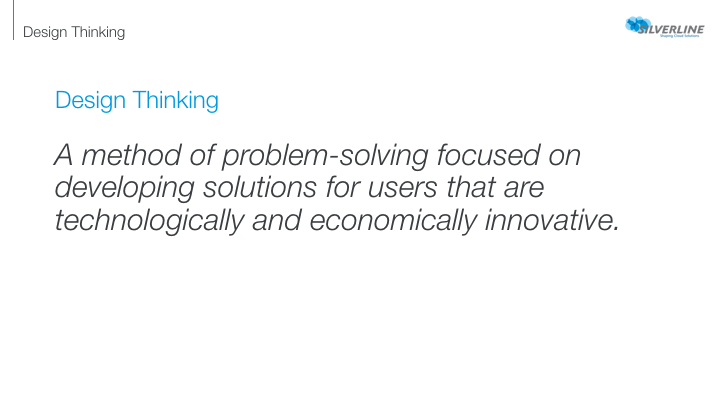Design Thinking Workshop Skeleton
Inspired by my workshop experience, Design Thinking for Entrepreneurs, at Grow with Google NYC - I decided to adapt it for uses at Silverline and beyond. Currently used as part of new hire orientation as an in-person workshop to help introduce design thinking concepts and as a team building experience.
Below the workshop skeleton you’ll find the first version from a pilot. One piece of feedback from the pilot: “More time, fewer participants, better clarity of language. Much of my confusion came from the total freedom allowed within the workshop, providing some guideposts or suggestions would have set me on a clearer path.”
Design Thinking Workshop
Definition & SL Context
What is Design Thinking?
- Design thinking, a method of problem-solving focused on developing solutions for users that are technologically and economically innovative.
- Design Thinking means focusing on the person and the experience, not the process
- Silverline’s Purpose Statement: To create rewarding experiences for our team, our clients, and the world we live in.
- We want to see the forest from the trees, seeing the big picture
- It helps us understand our clients’ environment, goals, obstacles, and needs
- Design thinking supports businesses and organizations to consider the real people who use our products and services; this means happy customers and a healthier bottom line
- It allows us to change our mindset from a linear mindset (like waterfall) to a more agile growth mindset
- We embrace the abstract nature of complex problems
- Design, not the product, but the whole experience
- Optional: For design thinking to be successful, you need to work well as a team. So have a conversation with your partner/team about how you work - your working style.
The Process
Empathize -> Define -> Ideate -> Prototype -> Test
New hires placed into small teams of 2-3.
Important Tool: What is Timeboxing?
- Timeboxing is allotting a fixed unit of time for an activity. That unit of time is called a time box.
- Timeboxing is a simple and effective way to manage your own, and your team members’ time efficiently. For yourself, this ensures that you don’t spend too long on a task that isn’t worth the effort. For team members, it helps to ensure that they don’t over-work solutions and that they budget their time/effort.
- The goal of timeboxing is to define and limit the amount of time dedicated to an activity.
Empathize
- User and their situation
- As a new Silverline, I want to …. so that I …
What is a user story:
- The Rosetta Stone between the problem (the client wants/needs) and the solution
- Taking information from the client and being able to form a project to get to the solution
User Story Components:
- Key factors in a user story
- Actor
- Scenario
- Problem
- Want/need
- Solution
How do I form a user story:
- As a….I should….so that I
- As a…I want to…so that I
Mind Map Activity
- Mind Map Instructions:
- On a large blank piece of paper, write your central topic or challenge in the middle of the paper and circle it.
- Ask your team, “What else can we add to the map that is related to this theme?” Write down ideas, branching out from the center, and don’t worry if they feel clichéd or obvious. That happens to everyone. Try to uncover obstacles, needs, and goals of your user.
- Use each connection to spur new ideas. If you think one of your ideas will lead to a whole new cluster, draw a quick rectangle or oval around it to emphasize that it’s a hub.
- Keep going. As the map progresses, your mind will open up, and you’ll likely discover some wild, unpredictable, dissociative ideas.
- You are done when the page fills or the ideas dwindle. If you’re feeling warmed up but not finished, try to reframe the central topic and do another mindmap to get a fresh perspective. If you feel you’ve done enough, think about which ideas you would like to move forward with.
Define
- Problem Statement template
- How might we…?
- Good problem statements are:
- Phrased as a question
- User-centered, framed according to specific users
- Narrow in scope but broad enough for creativity; not trying to solve the problem in the statement
- Example: How might we help new Silverliners easily find resources from past projects?
Ideate
- Crazy Eights
- Using the problem statement as a spark of creativity, fill in the 8 boxes with ideas
- Explore a wide variety of possible solutions through generating a large quantity of diverse possible solutions, allowing you to step beyond the obvious and explore a range of ideas
- Don’t worry about feasibility right now. Blue-sky thinking is encouraged.
- Each team member presents a favorite idea to your team
Prototype
- Vote on or combine ideas as a proposed solution
- Draw/flesh out your solution on a piece of paper together
- Storyboard it
- Create a narrative to illustrate
- Diagram with annotations
- Act it out
Test
- Present your solution to another group
- Get feedback
- What insights were gained? Write 3 things for your next iteration as next steps
- What might you do better?
- What might you change?
Design Thinking Workshop Pilot
